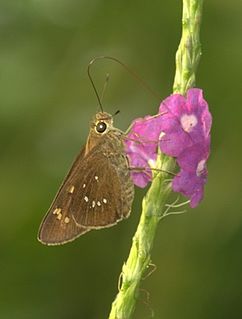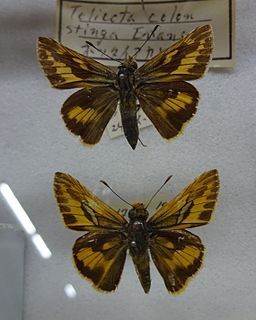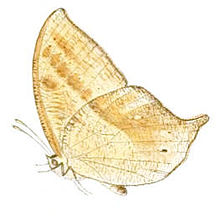
Parantica aglea, the glassy tiger, is a butterfly found in Indomalayan realm that belongs to the crows and tigers, that is, the danaid group of the brush-footed butterflies family.

Mycalesis oculus, the red-disc bushbrown, is a satyrine butterfly found in southern India. It is similar in markings to Mycalesis adolphei but distinguished by the reddish band around the large apical spots on the upper forewings.

Papilio helenus, the red Helen, is a large swallowtail butterfly found in forests of southern India and parts of southeast Asia.

Bibasis gomata, commonly known as the pale green awlet, is a butterfly belonging to the family Hesperiidae. It is found in Northeast India, the Western Ghats and parts of Southeast Asia. The butterfly was reassigned to genus Burara by Vane-Wright and de Jong (2003) and is considered by them to be Burara gomata.

Halpe homolea, the Indian ace or Ceylon ace, is a butterfly belonging to the family Hesperiidae.

Halpe porus, or Moore's ace, is a butterfly belonging to the family Hesperiidae, found in India.

Pelopidas conjuncta, the conjoined swift, is a butterfly belonging to the family Hesperiidae found in India.

Telicota colon, commonly known as the pale palm dart or common palm dart, is a butterfly belonging to the family Hesperiidae found in India to Australia.

Thoressa astigmata, the southern spotted ace, is a butterfly belonging to the family Hesperiidae. The species was first described by Charles Swinhoe in 1890. It is endemic to the Western Ghats of India and is found in the states of Kerala, Tamil Nadu and Karnataka.

Hyarotis microstictum, the brush flitter, is a butterfly belonging to the family Hesperiidae. It is found in the Indomalayan realm and in South India. H. m. coorga Evans, 1949 is the subspecies found in South India. H. m. microstictum is the subspecies found in the Indomalayan realm.

Troides minos, the southern birdwing, also called Sahyadri birdwing, is a large and striking swallowtail butterfly endemic to south India. With a wingspan of 140–190 mm, it is the second largest butterfly of India. It is listed as Least Concern in the IUCN Red List.

Papilio crino, the common banded peacock, is a species of swallowtail (Papilionidae) butterfly found in parts of the Indian subcontinent, including India, Nepal, Bhutan and Sri Lanka.

Idea malabarica, the Malabar tree nymph, is a large butterfly found in peninsular India. that belongs to the danaid group of the family Nymphalidae. It is found in forest clearings and above the forest canopy.

Libythea myrrha, the club beak, is a butterfly found in India that belongs to the Libytheinae group of the brush-footed butterflies family found in the Indomalayan realm.

Bindahara phocides, the plane, is a small butterfly found Indomalayan and Australasian realms that belongs to the lycaenids or blues family.

Lampides boeticus, the pea blue, or long-tailed blue, is a small butterfly that belongs to the lycaenids or gossamer-winged family.

Arhopala centaurus, the centaur oakblue or dull oakblue, is a species of lycaenid or blue butterfly found in India and southeast Asia to the Philippines.

Rathinda is a butterfly genus in the family Lycaenidae. It consists of a single species, Rathinda amor, the monkey puzzle, found in Sri Lanka and India.

Deudorix isocrates, the common guava blue, is a butterfly in the family Lycaenidae. It was described by Johan Christian Fabricius in 1793. It is found in India, Sri Lanka and Indochina in the Indomalayan realm. Other common names include pomegranate butterfly, and anar butterfly.

Heteropsis davisoni, the Palni bushbrown, is a species of satyrine butterfly found in southern India. Some authors consider this as a subspecies of Heteropsis mamerta or Mycalesis malsara or Mycalesis lepcha.





















